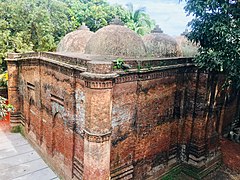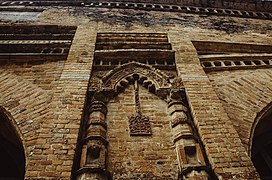Baba Adam's Mosque
This article needs additional citations for verification. (April 2019) |
| Baba Adam's Mosque | |
|---|---|
বাবা আদম মসজিদ | |
 | |
| Religion | |
| Affiliation | Sunni Islam |
| Location | |
| Location | Munshiganj District, Bangladesh |
| Geographic coordinates | 23°33′23″N 90°29′47″E / 23.556431°N 90.496350°E |
| Architecture | |
| Architect(s) | Malik al-Muazzam Malik Kafur |
| Type | Mosque |
| Style | Islamic architecture |
| Funded by | Jalaluddin Fateh Shah |
| Date established | 1483 AD |
| Specifications | |
| Length | 14.30m |
| Width | 11.45m |
| Interior area | 69.8625m² |
| Dome(s) | 6 |
| Website | |
| www | |
Baba Adam's Mosque (Bengali: বাবা আদম মসজিদ, Arabic: مسجد بابا آدم) is a mosque situated in the village of Qadi Qasbah under Rampal Union of Bangladesh's Munshiganj District. It was constructed in 1483 A.D by Malik Kafur to function as a Jami mosque during the reign of Jalaluddin Fateh Shah.[1] The tomb of Baba Adam Shahid, a 15th-century Muslim preacher, lies near the edifice.
History[edit]


According to the Arabic calligraphy inscription fixed aloft the central doorway in the east, the mosque was built in Rajab 888 A.H (August/September 1483 AD) during the reign of the Sultan of Bengal Jalaluddin Fateh Shah. It was constructed by Malik al-Muʿazzam Malik Kafur, one of the Sultan's officers.[2][3] According to historian Ahmad Hasan Dani, Kafur was of Abyssinian origin.[4] Now a protected monument under the Department of Archaeology, the mosque has been renovated and remains in a good state of preservation.
Architecture[edit]
Split into two aisles and three bays, the rear of the wall on the west is displayed in three steps of which the middle part contains a multi-cusped ornamental arch-panel. The brick building is roofed over by six identical domes divided into two rows. Two freestanding slender octagonal-based black basalt pillars have chain and bell motifs. Stone pillars hold the pointed two-centred arches of the six domes.[5]
All the entrances and mihrabs are recessed within rectangular frames. The south and north walls contain rectangular niches. The multi-domed mosque does not have a minaret. On both sides of the central doorway there are two multi-cusped rectangular panels. The arches are supported on faceted small pillars and decorated with a beautiful terracotta floral design and a hanging motif. This type of facade decoration is also found in Shahzadpur Mosque (Sirajganj).[6]
Gallery[edit]
-
Alternate view
-
Design
-
Motif
-
Corner
-
Pillar
See also[edit]
References[edit]
- ^ Michell, George, The Islamic Heritage of Bengal, p. 128, ISBN 978-9231021749
- ^ Ahmed, Abu Sayeed M. (2006). Mosque Architecture in Bangladesh. UNESCO Dhaka. p. 98. ISBN 978-984-32-3469-8.
- ^ Ahmed, Dr. Nazimuddin, Discover the Monuments of Bangladesh, p. 158
- ^ Ahmad Hasan Dani. "Analysis of the Inscriptions". Asiatic Society Of Pakistan Vol-ii. pp. 35 and 99.
- ^ Begum, Ayesha (2012). "Bangladesh". In Sirajul Islam; Miah, Sajahan; Khanam, Mahfuza; Ahmed, Sabbir (eds.). Banglapedia: the National Encyclopedia of Bangladesh (Online ed.). Dhaka, Bangladesh: Banglapedia Trust, Asiatic Society of Bangladesh. ISBN 984-32-0576-6. OCLC 52727562. OL 30677644M. Retrieved 30 April 2024.
- ^ "Baba Adam's Mosque". munshigonj.com. Archived from the original on 2017-07-08. Retrieved 2018-10-05.







